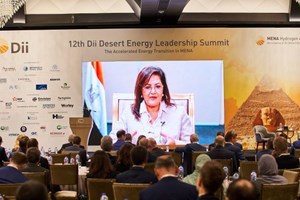News
Dii Desert Energy Leadership Summit: Green energy advancements in the MENA region
The 12th Dii Desert Energy Leadership Summit took place in Cairo, Egypt. At this summit, top leaders and decision-makers in the Middle East and North Africa (MENA) and international renewables sector gathered to discuss the markets for renewables, green molecules and energy storage.
The summit began with a presentation on the hydrogen (H2) controversy, presented by Frank Wouters, Senior Vice President of New Energy for Reliance Industries. Wouters focused on the cost considerations associated with the infrastructure and storage of H2. According to Wouters, investing in two infrastructures is better than one. He claimed that a combination of battery and fuel cell electric vehicles is the best scenario. For example, Germany would save approximately $40 B.
Dr. Hala Elsaid, Egyptian Minister of Planning and Economic Development, then spoke about Egypt’s steps towards building its renewable energy capacity and ensure its sufficiency. Dr. Elsaid said they are offering several partnership mechanisms through the Sovereign Fund of Egypt, a private investment fund to shape, manage and perfect opportunities for investment in Egypt’s state-owned assets.
“The Sovereign Fund is actively involved in renewable energy projects and contributes substantially to Egypt’s energy transition,” said Dr. Hala Elsaid. “The fund seeks to attract private investors to unique opportunities that lie in Egypt’s abundant natural resources, including sunlight and wind. Expanding Egypt’s renewable energy production capacity will enable it to become a pioneer in areas like green bunkering, green water desalination, as well as the export of green ammonia and e-methanol.”
Dr. Elsaid went on to discuss the interest in green H2. She said that the Sovereign Fund is seeking to invest in green H2 production projects, noting a project that would be announced at COP27.
Following was a panel discussion focused on Egypt as a green energy hub. The panel was joined by Cornelius Matthers, CEO of Dii Desert Energy; H.EE Waleid Gamal El-Dien, Chairman of Suez Canal Economic Zone; Hussain Al Nowais, Chairman of AMEA Power; Ayman Mohamed Soliman, CEO of Sovereign Fund of Egypt; Henry Boyd-Carpenter, Managing Director, Climate Strategy and Delivery, European Bank for Reconstruction and Development; and François Dao, Vice President, Middle East and Africa, EDF Renewables.
The discussion begins with the panelists describing the Dii Desert Energy initiative. The initiative is to enable the market for green electrons and molecules, collaborating with people and countries toward the energy transition in the MENA region. According to the panelists, the MENA deserts can power the world’s 160,000-terawatt hour (TWh) energy needs. Egypt is leading the installed renewable energy capacity in the MENA region.
They touched on the cost reductions of rapid wind, solar photovoltaics (PV), batteries and electrolyzers, making renewables more attractive than fossil fuels or nuclear energy. According to the IRENA Renewable Cost Database, the global weighted average of levelized cost of electricity (LCOE) for offshore wind fell 56%, and the LCOE for PV fell 85% between 2010 and 2020.
The panelists ended the conversation by referencing the 61 H2 projects recently announced in the MENA region; 85% are green H2-focused. Egypt boasts the most projects (24), followed by Oman (8) and the United Arab Emirates (7).
Story by: Tyler Campbell, Managing Editor, H2Tech


